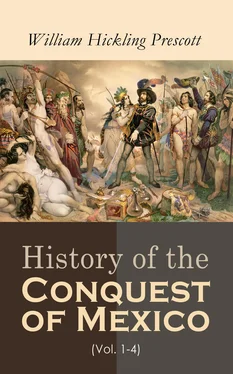Southey’s Madoc, part 2, canto 26.
[209]I borrow the words of the summons by which the people were called to the ludi seculares , the secular games of ancient Rome, “ quos nec spectâsset quisquam, nec spectaturus esset .” (Suetonius, Vita Tib. Claudii, lib. 5.) The old Mexican chroniclers warm into something like eloquence in their descriptions of the Aztec festival. (Torquemada, Monarch. Ind., lib. 10, cap. 33.—Toribio, Hist. de los Indios, MS., Parte 1, cap. 5.—Sahagun, Hist. de Nueva-España, lib. 7, cap. 9-12. See, also, Gama, Descripcion, Parte 1, pp. 52-54,—Clavigero, Stor. del Messico, tom. ii. pp. 84-86.) The English reader will find a more brilliant coloring of the same scene in the canto of Madoc above cited,—“On the Close of the Century.”
[210] E.g. , gunpowder and the compass.—M.
[211]This latter grain, according to Humboldt, was found by the Europeans in the New World, from the South of Chili to Pennsylvania (Essai politique, tom. ii. p. 408); he might have added, to the St. Lawrence. Our Puritan fathers found it in abundance on the New England coast, wherever they landed. See Morton, New England’s Memorial (Boston, 1826), p. 68.—Gookin, Massachusetts Historical Collections, chap. 3.
[212]Torquemada, Monarch. Ind., lib. 13, cap. 31.—“Admirable example for our times,” exclaims the good father, “when women are not only unfit for the labors of the field, but have too much levity to attend to their own household!”
[213]A striking contrast also to the Egyptians, with whom some antiquaries are disposed to identify the ancient Mexicans. Sophocles notices the effeminacy of the men in Egypt, who stayed at home tending the loom, while their wives were employed in severe labors out of doors:
“ΟΙ. ὦ πάντʹ ἐκείνω τοῖς ἐν Αἰγύπτῳ νόμοις
φύσιν κατεικασθέντε καὶ βίου τροφάς·
ἐκεῖ γὰρ οἱ μὲν ἄρσενες κατὰ στέγας
θακοῦσιν ἱστουργοῦντες, αἱ δὲ σύννομοι
τἄξω βίου τροφεῖα πορσύνουσʹ ἀεί.”
Sophocl., Œdip. Col. v. 337-341.
[214]Torquemada, Monarch. Ind., lib. 13, cap. 32.—Clavigero, Stor. del Messico, tom. ii. pp. 153-155.—“Jamas padeciéron hambre,” says the former writer, “sino en pocas ocasiones.” If these famines were rare, they were very distressing, however, and lasted very long. Comp. Ixtlilxochitl, Hist. Chich., MS., cap. 41, 71, et alibi.
[215]Oviedo considers the musa an imported plant; and Hernandez, in his copious catalogue, makes no mention of it at all. But Humboldt, who has given much attention to it, concludes that, if some species were brought into the country, others were indigenous. (Essai politique, tom. ii. pp. 382-388.) If we may credit Clavigero, the banana was the forbidden fruit that tempted our poor mother Eve! Stor. del Messico, tom. i. p. 49, nota.
[216]Rel. d’un gentil’ huomo, ap. Ramusio, tom. iii. fol. 306.—Hernandez, De Historiâ Plantarum Novæ Hispaniæ (Matriti, 1790), lib. 6, cap. 87.
[217]Sahagun, Hist. de Nueva-España, lib. 8, cap. 13, et alibi.
[218]The farmer’s preparation for his crop of Indian corn was of the simplest. He simply cut away the dense growth from his corn-field and burned it. The ashes thus secured were the only fertilizer used. Just before the first rain in May or June he made holes with a sharpened stick, and at regular intervals, in the prepared ground, and into them dropped four or five grains of corn. In the later days of the Aztec domination considerable care was taken of the growing crops. They were kept free from weeds and in some cases irrigated. Boys stationed on elevated platforms or trees frightened away the birds.—M.
[219]Carta del Lic. Zuazo, MS.—He extols the honey of the maize, as equal to that of bees. (Also Oviedo, Hist. natural de las Indias, cap. 4, ap. Barcia, tom. i.) Hernandez, who celebrates the manifold ways in which the maize was prepared, derives it from the Haytian word mahiz . Hist. Plantarum, lib. 6, cap. 44, 45.
[220]And is still, in one spot at least, San Ángel,—three leagues from the capital. Another mill was to have been established, a few years since, in Puebla. Whether this has actually been done, I am ignorant. See the Report of the Committee on Agriculture to the Senate of the United States, March 12, 1838.
[221]Before the Revolution, the duties on the pulque formed so important a branch of revenue that the cities of Mexico, Puebla, and Toluca alone paid $817,739 to government. (Humboldt, Essai politique, tom. ii. p. 47.) It requires time to reconcile Europeans to the peculiar flavor of this liquor, on the merits of which they are consequently much divided. There is but one opinion among the natives. The English reader will find a good account of its manufacture in Ward’s Mexico, vol. ii. pp. 55-60.
[222][Ober (Travels in Mexico) gives a very full account of the uses to which the maguey is put. On the maguey plantations the plants have an average value of five dollars. “A long train departs every day from the stations on the plains of Apam, loaded exclusively with pulque , from the carriage of which the railroad derives a revenue of above $1000 a day,” p. 345. The pulque “tastes like stale buttermilk and has an odor at times like that of putrid meat.” It is wholesome and refreshing. Mexicans ascribe to it the same beneficent properties which Scotsmen assign to their whiskey.—M.]
[223]Hernandez enumerates the several species of the maguey, which are turned to these manifold uses, in his learned work, De Hist. Plantarum. (Lib. 7, cap. 71, et seq.) M. de Humboldt considers them all varieties of the agave Americana , familiar in the southern parts both of the United States and Europe. (Essai politique, tom. ii. p. 487, et seq.) This opinion has brought on him a rather sour rebuke from our countryman the late Dr. Perrine, who pronounces them a distinct species from the American agave , and regards one of the kinds, the pita , from which the fine thread is obtained, as a totally distinct genus. (See the Report of the Committee on Agriculture.) Yet the Baron may find authority for all the properties ascribed by him to the maguey, in the most accredited writers who have resided more or less time in Mexico. See, among others, Hernandez, ubi supra.—Sahagun, Hist, de Nueva-España, lib. 9, cap. 2; lib. 11, cap. 7.—Toribio, Hist, de los Indios, MS., Parte 3, cap. 19.—Carta del Lic. Zuazo, MS. The last, speaking of the maguey, which produces the fermented drink, says expressly, “With what remain of these leaves they manufacture excellent and very fine cloth, resembling holland, or the finest linen.” It cannot be denied, however, that Dr. Perrine shows himself intimately acquainted with the structure and habits of the tropical plants, which, with such patriotic spirit, he proposed to introduce into Florida.
[224]The first regular establishment of this kind, according to Carli, was at Padua, in 1545. Lettres Américaines, tom. i. chap. 21.
[225][Though I have conformed to the views of Humboldt in regard to the knowledge of mining possessed by the ancient Mexicans, Señor Ramirez thinks the conclusions to which I have been led are not warranted by the ancient writers. From the language of Bernal Diaz and of Sahagun, in particular, he infers that their only means of obtaining the precious metals was by gathering such detached masses as were found on the surface of the ground or in the beds of the rivers. The small amount of silver in their possession he regards as an additional proof of their ignorance of the proper method and their want of the requisite tools for extracting it from the earth. See Ramirez, Notas y Esclarecimientos, p. 73.]
Читать дальше












